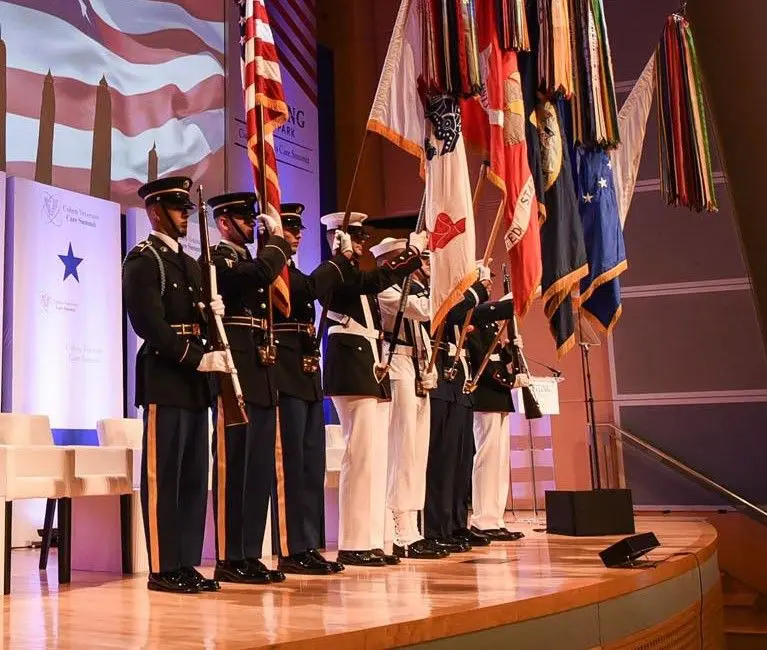
- Service
Cohen Veterans Care Summit
Convening private and public sector leadership to advance Veterans brain health research and clinical care.
Brain trauma affects millions. Learn about traumatic brain injury (TBI) and post-traumatic stress disorder (PTSD) and how they impact civilians and Veterans.

Understand brain trauma (TBI/PTSD) and the current state of research.
TBI symptoms, diagnosis, treatment, and the impact of our research.
PTSD symptoms, diagnosis, treatment, and the impact of our research.
Learn about suicide risk among military Veterans with brain trauma.
A new Community Coordination model to accelerate a first generation of diagnostics and treatments for Traumatic Brain Injury.
Cohen Veterans Bioscience is a non-profit 501(c)(3) biomedical research and technology organization dedicated to advancing brain health by fast-tracking precision diagnostics and tailored therapeutics.

Explore our Mission & Vision to advance solutions for brain trauma.
Meet the minds behind CVB.
Meet our Board of Directors.
A voice for the Veterans community.
Read stories from people living with brain trauma.
Interested in joining the team? Explore careers at CVB.
Connect with the experts at CVB.
Our approach is to build enabling platforms with strategic partners and to adopt a team science approach to fast-track solutions in years, not decades.

Fast-tracking diagnostics & therapeutics for brain trauma.
Advocating at the federal, state, and local levels.
Helping high-impact research succeed.
Driving quality & reproducibility in science.
Explore our research publications.
Advancing our understanding of invisible wounds.
Learn how to participate in clinical trials.
Fostering a collaborative approach to research.
Donate today to advance solutions for brain trauma. Together, we can advance research and improve lives.
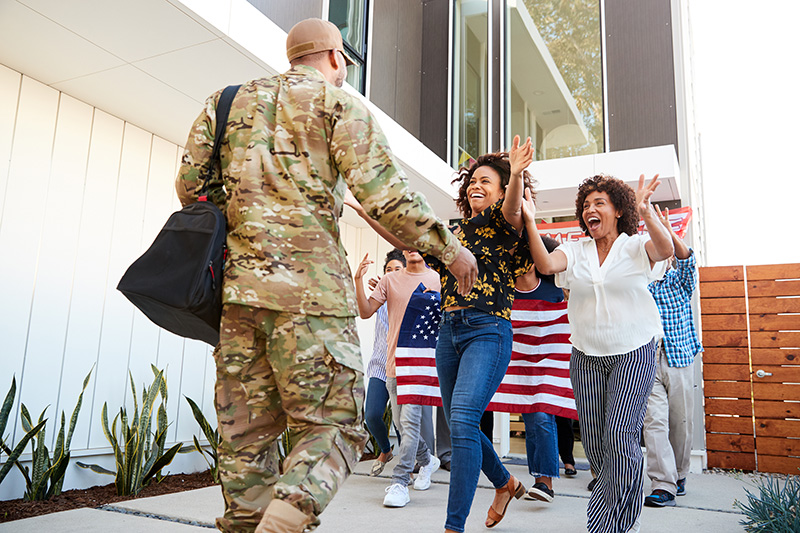
Get the latest updates in PTSD & TBI research.
Share your story: how has TBI impacted you?
We look forward to hearing from you.
Learn about the latest news & events from CVB.
View press releases and more.
A new Community Coordination model to accelerate a first generation of diagnostics and treatments for Traumatic Brain Injury.
I grew up in a military family so we moved around a lot while my Dad was in the Air Force. While he was doing his tours in Vietnam, my Mom and I lived in Japan. It was great exposure to a totally different culture and I enjoyed the whole sense of adventure. Ultimately, my father retired from the Air Force in the Pacific Northwest. He really inspired me to pursue a career in military service and I entered the Air Force Academy right after I graduated high school, electing to serve in the Navy.
I feel privileged to work with a group of highly motivated and committed young Americans. They understand the risks and rewards of their chosen profession and serve our nation to the utmost of their ability.
Over the last 15 years, and since 9/11, we have gained an increasing understanding of the importance of properly taking care of our prime resource and flagship weapons system – our people. Their physical, emotional, and spiritual wellbeing and that of their families, are critical to retaining and sustaining the hard-earned experience necessary to win. Over time, we have implemented critical initiatives to take care of our warriors. We have institutionalized resilience by routinely measuring and assessing the effectiveness of these initiatives, and share best practices across the U.S. Special Operations Command (USSOCOM). The health and resilience of the force is a key priority and necessity for all USSOCOM components. Service-connected traumatic brain injury (TBI), post-traumatic stress (PTS), and related manifestations like suicide are a reality. The ongoing evolution of our ability to recognize and support our people with effective care both during and after service is a direct reflection of the value placed on their service.
It is clear that Secretary Mabus cares deeply for his sailors. The policy that he and the Navy implemented is as necessary as it is progressive. In my time at Naval Special Warfare Command, the Chief of Naval Personnel and I were personally and routinely engaged on cases where sailors with verifiable service-connected challenges were at odds with certain personnel policies that did not enable us to fully address our obligations to take care of our people in a way that was needed. This new policy reflects numerous cases where we sought exceptions in order to take care of our sailors, and now allows commanders to consider and address greater dimensions of service-connected challenges.
I have a well-developed interest in advancing the care of both active duty and veteran service members. The summit is a great opportunity to share perspectives and appreciation with all of the communities engaged in this effort.
I hope that a better understanding of the challenges and potential positive impacts of this effort are understood, and that an even greater sense of purpose and urgency is fostered from the summit.
I think that there is definitely a greater awareness and prioritization to get to more effective treatment protocols. There are numerous initiatives and policies that speak directly to suicide prevention and support across the services and specifically within USSOCOM. However, it would probably be a stretch to attribute all suicide concerns to TBI, PTS, or purely service-connected matters.
All of my most memorable experiences center on people – working through complex problems, overcoming perceived limitations and obstacles, and demonstrating the power of the human spirit – “what the mind can conceive, the body will achieve.”
I am excited about the many possibilities to consider. I can only hope that the next three decades will be as purposeful as the last three.

As the days advanced, I became the USSS Ground Zero supervisor and liaison. On Friday, September 14th, I was asked to brief and share with President George W. Bush what it was like to be on the street that day. Together we looked up at the smokey sky where three huge skyscrapers once stood. I told him that life and death that morning was often decided between whether one simply stepped to the right or the left.
I left Ground Zero and New York City on Dec. 7th, 2001, but not before witnessing that day a heavy construction crew pull an I-beam out of the ground that was still steaming hot on the end as they wet it down with water. I had been transferred back to Washington, DC, reassigned to take over White House complex security operations for the USSS.
Two weeks after Sept. 11th, my 14-year-old son Ryan came to me and asked me to take him down to Ground Zero. Ryan had witnessed that day unfold from a ridgeline just west of New York City on the edge of the town where we lived. When I came home on the night of 9/11, Ryan had given me a huge tear-filled bear hug. However, over the next couple of weeks he got quiet and began to withdraw.
Ryan told me that he needed to go down to the WTC complex to understand what happened. He had been there many times in the past for different memory filled events. I initially resisted, as did his mother, who promptly said “no way…bad idea”.
Something told me that he needed to do this, so I took him down to Ground Zero and dressed him up in a police jacket, hard hat and respirator to hide his identity. We had an agreement that if I detected any signs that he wasn’t handling the trip, he was out of there. Ground Zero two weeks after 9/11 was a very ugly place on many fronts as it had transitioned from a rescue to a recovery operation. I escorted Ryan for three hours around the immense debris field, explaining where buildings once stood and what had happened that day to the best of my recollection. When we finished, he had a look of determination in his eyes and said that this trip to Ground Zero helped him understand.
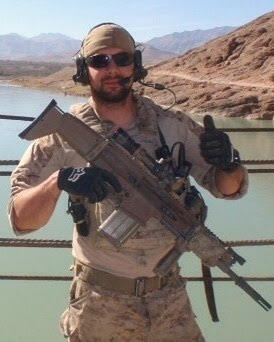
Ryan graduated from an Annapolis area high school in 2005 and began diving year-round as a salvage diver in and around the Chesapeake Bay. One day he came home and announced that he had enlisted in the Navy and then added that he had volunteered for SEAL training.
I thought my wife was going to take my head off, as she was holding me responsible for this surprise announcement. I assured her that I wasn’t prompting him but did assert that he needed to cut his own path in life, that this was his decision. I made sure that Ryan knew what he signed up for and what he was getting into, introducing him to several recent combat-hardened frogmen.
When I asked Ryan why he wanted to join up, he replied, “I am going to be part of the solution. What happened to us on 9/11 can’t ever happen to us again.”
As Ryan entered the Navy, I retired from the USSS after 22 years and soon found myself being recruited back into the Department of Defense to work on the counter-IED (improvised explosive device) threat that was taking down and maiming so many of our warriors deployed to both Iraq and Afghanistan.
The IED was the main weapons system employed by extremist terror elements looking to paralyze our freedom of movement on the battlefield and to erode national support at home through graphic visual recordings of explosive attacks on our forces.
Ironically, I started with the SEAL Teams 30 years prior, the same age as Ryan. I had come full circle to eventually support Ryan and his SEAL teammates as they confronted the IED threat and the extremist networks that they were up against. As a senior leader for DoD’s Joint IED Defeat Organization (JIEDDO) and Director of the Counter IED Operations-Intelligence Integration Center (COIC), I traveled many times into the war theaters supporting both conventional and special operations forces.
One day my wife said something that hit me dead center in my heart. She said that while I was overseas, she had dinner one night with her girlfriends who were all complaining that the school bus was never on time to pick up their kids, about their husbands coming home from work late and not being able to get the week at the beach that they wanted. One of my wife’s girlfriends turned toward her and asked about what was going on in our home. My emergency room nurse wife replied without emotion, “Oh, we’re fine, Ryan is in Iraq and Frank is in Afghanistan.”
Ryan started Navy basic training at the Great Lakes Naval Training Center in May of 2006. The next spring, he entered Basic Underwater Demolition-SEAL (BUD/S) training in San Diego, receiving his SEAL Trident in October 2008 as part of Class #268.
Ryan had numerous combat deployments to Iraq and Afghanistan as an 18-D special operations medic and SEAL sniper. He eventually served as the lead petty officer (LPO) for Special Operations Urban Combat (SOUC) training. SOUC was the pre-deployment training phase for SEAL platoons deploying to overseas assignments.
The training realistically mirrored the environment that the deploying platoons would encounter. As the LPO, Ryan continued to be exposed to blast overpressure and physical forces from weapons firing, use of explosives, tactical simulations and helicopter operations.
In the spring of 2015, Ryan began seeking help for severe insomnia that further evolved into increased anxiety, memory loss, headaches, loss of coordination, vision problems and other uncharacteristic conditions that were progressively eroding his physical and mental health. A year later, Ryan was honorably discharged from the Navy after being diagnosed with PTSD and related conditions.
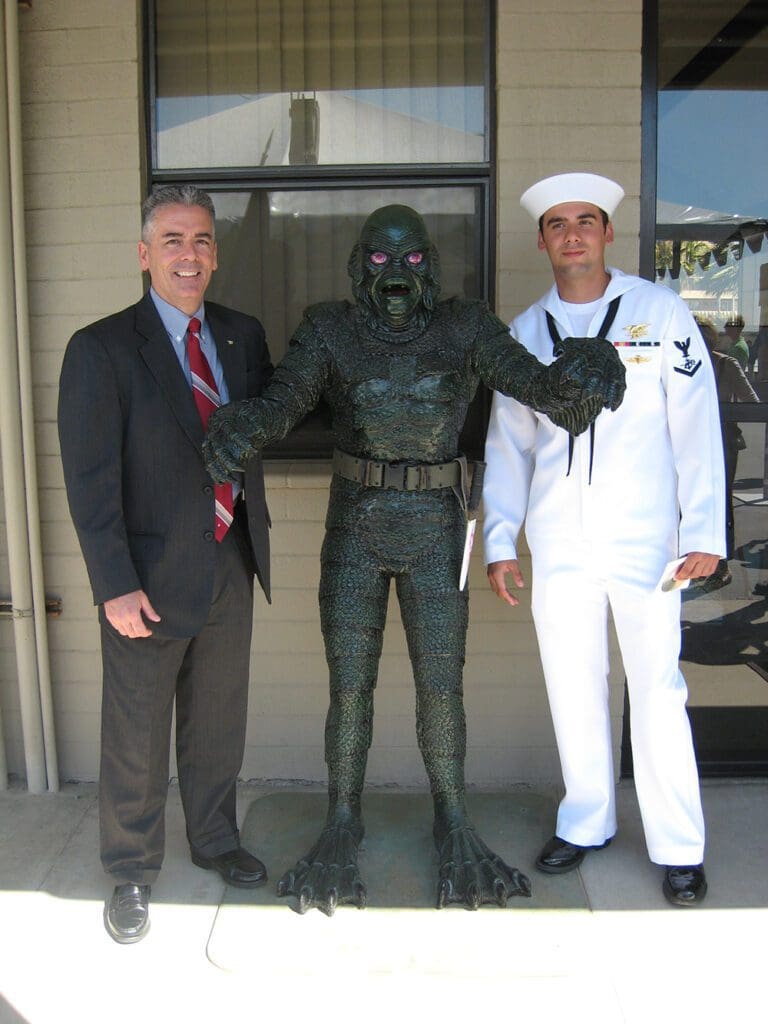
Ryan continued to spiral down from what he once was, a highly regarded and revered SEAL operator. He informed us that if anything ever happened to him, he wanted his brain donated for traumatic brain injury/Breacher’s Syndrome research.
Ryan died by suicide on April 23, 2017, from invisible wounds suffered in service to the Teams and this nation. At the time of his death, he was dressed in his SEAL Team-7 t-shirt, wore red-white-blue board shorts and had illuminated a shadow box beside him with all his medals, insignias and other symbolic memorabilia.
Following a postmortem examination of Ryan’s brain, we learned that he suffered from an undiagnosed severe level of microscopic brain injury uniquely related to military blast exposure. Military blast exposure that was suffered in both training for combat and combat operations. Ryan died from invisible wounds that were not invisible to him or our family, just invisible to the system and society largely blind to them.
I have stood firm that Ryan died from combat related injuries in service to this nation, he just didn’t die right away.
The 20th anniversary of 9/11 attacks will be an emotional rekindling of memories for the Larkin family in many ways, as it will be for others like us who have supported their loved ones working to be part of the solution.
It is an emotional time now for all of us as we witness the rapid decline of Afghanistan, as we wonder if it (Iraq and Afghanistan) was all worth it. That debate will be front and center on the political leadership that spanned multiple administrations and congresses over the past 20 years of war and global conflict.
As for my son and his teammates, they achieved personal accomplishments and experienced high adventure that goes beyond common definition or comprehension. Unless you were there alongside them and walked in their boots, you will not understand. Not one of them would trade away being a SEAL and the honor to wear the Trident. They did the job that we asked them to do — regardless of the reason or the outcome.
Conventional and special operations warriors, men and women from all parts of our society, made up an all-volunteer force that swore an oath to protect and serve us every day. Their selfless demonstration of personal strength and resiliency needs to be a guide-on for our society as we move forward to confront other inevitable challenges and threats.
We as a nation need to have the same strength, resiliency and commitment to ensure our national security. As for these revered warriors who have served us, we need to be there for them every day.
Many of them return from their service burdened by both the visible and invisible wounds of war. A recent Brown University study reported that our nation lost 7,057 warriors post 9/11 to the Global War on Terror. As an often-neglected footnote, the same study highlighted that over 30,000 warriors and veterans were lost to GWOT-related suicide since that beautiful Tuesday morning of Sept. 11, 2001.
Law enforcement officers, firefighters, EMTs, healthcare workers and other public service professionals or volunteers need the same level of reverence and recognition for their service to our communities and this nation. They have been our “domestic warriors” protecting our society every day with the same selfless commitment and compassion.
We must NEVER FORGET the many sacrifices founded on love that these valiant warriors, military or civilian, made for their teammates, families and nation so that we may continue to live free, healthy and secure.
Ryan loved being a SEAL and he loved the SEAL Teams. We miss his physical presence every day. We are comforted knowing that he and his fallen teammates are still out there in a different form protecting us every day.
Bob Harward is the Chief Executive (CE) for Lockheed Martin Middle East and has lived in Abu Dhabi for five years. A National Security Expert, in both theory and application, he served on the National Security Council for the Bush administration, commissioned the National Counter Terrorism Center, and has extensive combat experience as a US Navy SEAL, in Afghanistan, Iraq (he led invasions in both countries in Oct 2001 and Mar 2003), Syria, Somalia, Yemen and Bosnia, as well as the rest of the Middle East.
A US Naval Academy alumni, he holds a Masters degree in International Security Affairs, is a graduate of the Naval War College and the MIT Foreign Policy Program. He also served as an executive fellow at RAND. Prior to joining Lockheed Martin, he was a Vice Admiral (SEAL) in the United States Navy, with his last assignment as Deputy Commander, US Central Command (USCENTCOM).
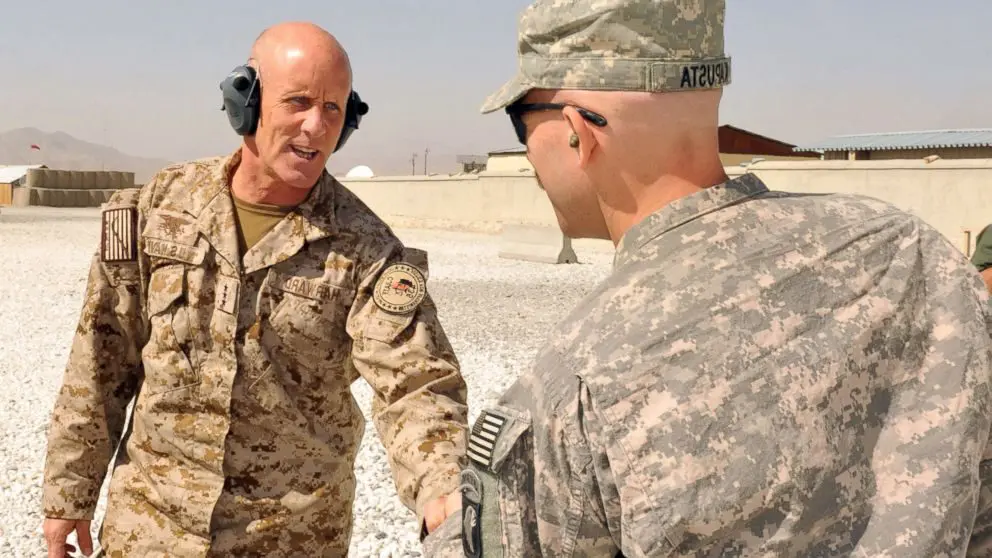
Hear directly from Harward on the importance of CVB's Veterans Advisory Council.
Since 1914, more than 100 years following the introduction of high explosives on the modern battlefield, we are still handicapped in our ability to diagnose the consequence of battle and exposure to blast. The recent discovery of a new pattern of microscopic level of brain injury, related to military blast exposure is calling into question our past approach for treating the poly-trauma effects of PTS, TBI, moral injury and use disorders. Presently, this pattern of microscopic blast TBI can only be qualified in post-mortem examination.
There is an urgent need to develop reliable diagnostic imaging and blood markers for TBI in a living person. Early identification of this injury manifestation and disease evolution is necessary to effectively treat the underlying brain injury that may be complicating the treatment of other combat related conditions, such as TBI, moral injury, use disorders and the nexus to suicides. The historic course of action for treating these abnormal presentations has defaulted toward psychiatric or behavioral health focused disorders and treatments that have largely incorporated the use of mood stabilizing medications. We urgently need to confirm or deny the presence of TBI in order to accurately characterize the variables challenging the veterans we are seeking to help.
Cohen Veterans Bioscience is focused on leveraging strict scientific peer reviewed processes to further knowledge of the diseases and injuries that challenge our veteran community. The national emphasis on caring for our wounded warriors has seen the emergence of many support programs and therapies. Few of these veteran directed solutions have had any serious level of scientific rigor applied to them to qualify or validate whether they are effective in their claims. As a stand alone non-profit entity, CVB is on a neutral platform to provide an unbiased assessment of these programs. Many of these programs have compelling anecdotal examples of success in helping both active duty and veterans in need.
The veteran in serious need of assistance is challenged either by a lack of visibility or knowledge about programs that have been either proven effective or ineffective. More often that not, a recommendation from a buddy or teammate guides many veterans to these program referrals. Struggling veterans and their families are emotionally vulnerable as they seek solutions. CVB’s effort to identify and confirm scientifically validated treatment and support programs reduces the risk that one of these active duty warriors or veterans goes down the wrong path. Veterans in desperate need cannot afford to trade off valuable time to effective care, not to mention being able to afford the high expense associated with many of these programs.
CVB’s attention to high scientific standards and evaluation methodologies can offer many of these promising programs the formal validation that will reach the high bar of trust and confidence for our veterans. Public and private organizations, along with government agencies would be able to leverage metrics for program or treatment validation. It would lead to more appropriate referrals for our veterans and further enhance collaboration for data collection and analysis.
The effort that Cohen Veterans Bioscience has underway pursuant to the recent DoD grant to study pharmaceuticals that have clinical efficacy for treating PTSD is significant. So many of our active duty warriors and veterans diagnosed with PTSD, TBI, moral injury, pain and use disorders have been prescribed a long list of drugs predominantly prescribed to treat symptoms, not the root cause of their problem. It would be irresponsible to state that all pharmaceutical therapies are bad. Truth be told, providers not completely qualified to evaluate therapeutic effectiveness or consequence, have prescribed many drugs without any sense of application. Pharmaceuticals have provided life stabilizing and life saving options for many challenged by disease and abnormal physiological or psychological conditions. Very few drugs since 2001 have been scientifically validated for the treatment of PTSD. To date, many practitioners have followed a course of “plug and play” for effect. This reflection is often voiced by veterans who have been prescribed dozens of medications in their pursuit to feel normal again, a life free of pain and fear.
CVB’s efforts to develop an accelerated and adaptive clinical trial, leveraging precision medical approaches for treatment and evaluation could very well change our path forward for treating PTSD. CVB’s design and validation of new and current pharmaceutical options will significantly illuminate what actually works on diagnosing, managing, extinguishing, and preventing PTSD. Considering the large numbers of active duty and veterans currently diagnosed with PTSD, this challenge has significant implications both within the military enterprise and in the civilian sector where PTSD also challenges many worldwide.
Cohen Veterans Bioscience’s effort to bring knowledge to government leaders and policymakers continues to have impact in advancing new agency authorizations, tasking provisions and targeted funding intended to fuel new research collaboration, information sharing, innovation and discovery. There are so many variables that make up the complex rubric allied to veterans brain health.
The second and third order effects related to a veteran’s health and stability touch family, friends, teammates and community. These brave men and women voluntarily stepped up on the line to serve this great nation with the goal of protecting our freedoms and ensuring our security. Many have gone into harm’s way at personal expense and sacrifice. We cannot leave any more of them behind. It is our national obligation to support those that have come home with both visible and invisible wounds. Our effort to deal with the consequences of their honorable service cannot be at the expense of a veteran’s dignity or sense of self worth. Unfortunately, 20 veteran suicides a day has become a horribly painful metric for this nation, we have a long challenging march ahead.
I am confident that if Cohen Veterans Bioscience can influence the development of new diagnostic imaging technology, blood marker indicators, and neuro-cognitive assessment for TBI in a living person, it will be a game changer for how we address combat related poly-trauma. We desperately need to define blast related TBI and its disease progression in our warrior population. This developmental effort, coupled with knowledge gained from companion longitudinal research on TBI, will undoubtedly lead to early diagnosis and targeted treatment for blast related brain injuries. It will clearly inform appropriate therapies, rehabilitative support and injury prevention that has a nexus to both training and combat operations.
I am very excited about energizing a large movement to vacuum data into the BRAIN Commons that I expect will illuminate connections that have not been visible to date. This cross cutting data integration and analytical effort will lead to the development of information leading to knowledge and decision support, that will further guide action and future direction. The BRAIN Commons will fuel collaboration and more research evolution that will elevate the opportunity to innovate and discover new solutions. I predict that in three to five years, we will have advanced brain health science beyond our expectations. As a result, we will be improving a meaningful post-service life experience for our veterans, reducing suicides and finding ways to prevent these destabilizing poly-trauma conditions.
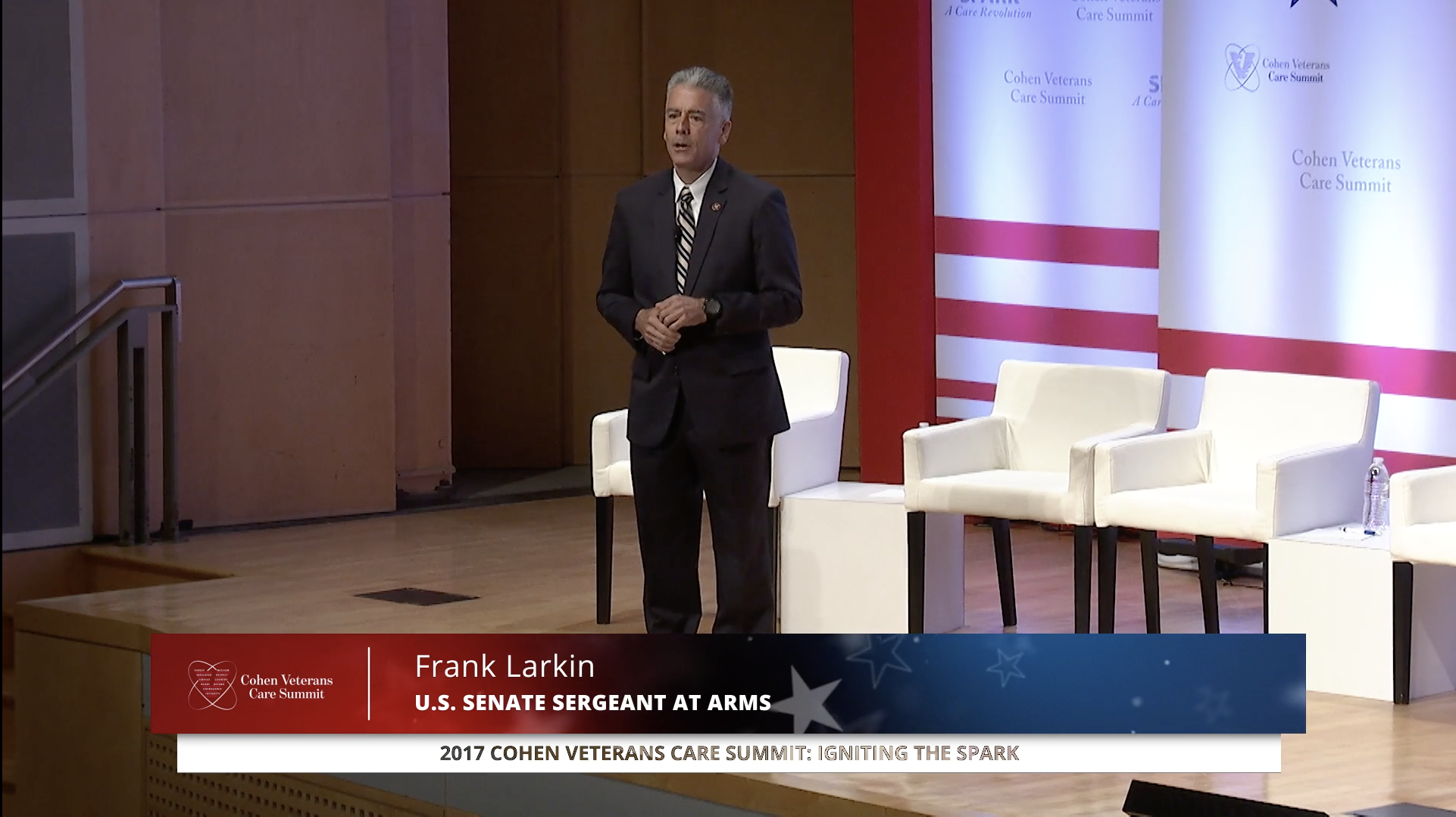
Hear his story firsthand as Frank Larkin presents at the 2017 Cohen Veterans Care Summit: Igniting the Spark
Frank Larkin served as the United States Senate Sergeant at Arms (SAA). As chief law enforcement and executive officer of the Senate, the SAA enforces rules of the Senate; provides a range of technical and administrative services to Senators in their Washington, DC, and state offices; and maintains security in the Capitol and Senate office buildings.
Frank was a member of the Senior Executive Service, recently serving as both the Acting Director and the Vice Director of the Joint Improvised Explosive Device Defeat Organization (JIEDDO) within the Department of Defense. He previously served as JIEDDO’s Director for the Counter IED Operations-Intelligence Integration Center. JIEDDO’s mission was to focus all Department of Defense actions in support of the combatant commanders’ efforts to defeat improvised explosive devices (IEDs) as weapons of strategic influence. Frank’s focus was in support of our deployed warfighters and special operations forces around the globe and the integration of a “whole of government” disruption effort targeting extremist networks that employ IEDs.
Frank served for more than two decades in the United States Secret Service (USSS), beginning in 1984 as a Special Agent assigned to the Philadelphia and Washington Field Offices, before assignment to the Presidential Protective Division. He was assigned to the Office of Congressional Affairs for a two-year fellowship on Capitol Hill, serving a year each with the Senate and House Appropriations Committees. Frank entered the USSS supervisory ranks as Assistant to the Special Agent in Charge of the New York Field Office, where he led financial, electronic, and organized crimes investigations. Following the events of 9/11, he returned to Washington, DC, as the Assistant Special Agent in Charge of the Presidential Protective Division, supervising White House security operations. As Assistant Special Agent in Charge of the Technical Security Division, Frank was responsible for tactical countermeasures programs. In 2004, he was promoted to the Senior Executive Service, assuming the position of Deputy Assistant Director for Protective Research and Chief Technology Officer.
Following his USSS career, Frank was Director, Program Management & Leadership, for the Raytheon Company, and more recently, worked at Lockheed Martin’s Defense & Intelligence Solutions, responsible for providing operations and intelligence analysis support to the intelligence community.
A veteran of the US Navy, Frank has a significant military and law enforcement special operations background, serving as a special warfare operator in the Navy SEALs. After his Navy service, he was a uniformed patrol officer with the Norristown (PA) Police Department, a homicide detective with the Montgomery County (PA) District Attorney’s Office, and a Maryland State Trooper-Flight Paramedic.
Frank holds a BA degree in criminal justice and an MS degree in public administration from Villanova University. He is the recipient of numerous awards, including the US Secret Service award for valor, the Department of the Army’s Exceptional Civilian Service award, and the Superior Civilian Service award.
These brave men and women voluntarily stepped up on the line to serve this great nation with the goal of protecting our freedoms…many have gone into harm’s way at personal expense and sacrifice. We cannot leave any more of them behind. It is our national obligation to support those that have come home with both visible and invisible wounds.
Frank Larkin
Member, Veterans Advisory Council
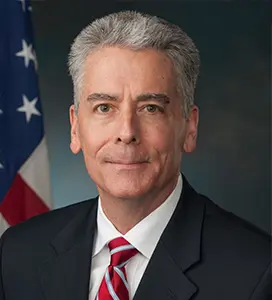
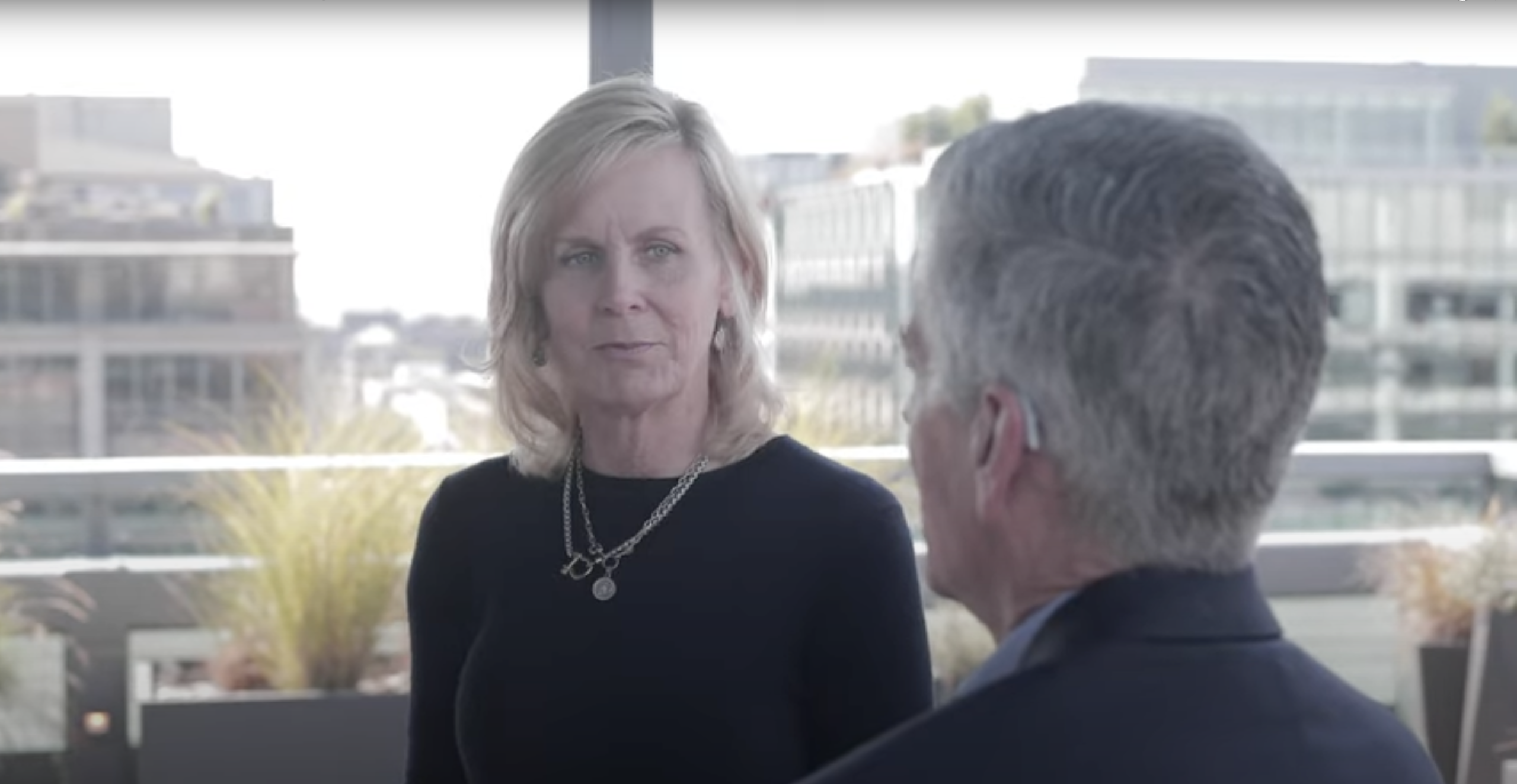
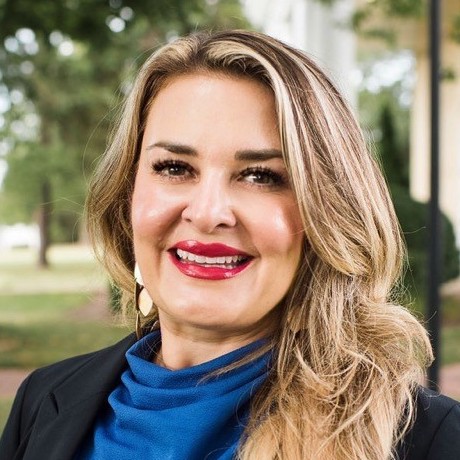
Jane Horton
Member, Veterans Advisory Council
Jane Horton
Member, Veterans Advisory Council
Ms. Jane Horton is a respected and influential global leader for national security, humanitarian, and veterans. A fearless and relentless advocate, she successfully fosters bipartisan collaboration on legislation, policies, and programs to better the lives of veterans, service members, their families, and those across the globe. Jane currently serves as a senior policy advisor in the United States Congress in Washington D.C. Previously, Jane was a senior advisor in the Office of the Secretary of Defense in the Pentagon. In this capacity, she advised on civilian and military personnel policy, military family policy, and international security affairs. She championed efforts to advance warfighter brain health and Gold Star family initiatives and has inspired or authored over twenty pieces of legislation in over a decade. Some of Jane’s additional experiences include serving as a special assistant to the Chairman of the Joint Chiefs of Staff, General Joseph Dunford, an advisor to the Chief of Staff of the Army, and the congressional and military liaison to the Ambassador of Afghanistan to the United States. She currently serves on the board of directors of numerous non-profits and is a proud member of Georgetown University's US- Afghan Women's Council.
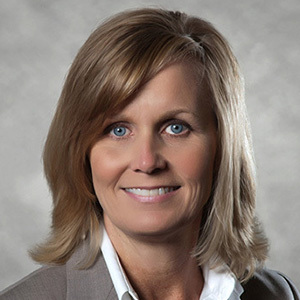
Robin King
Member, Veterans Advisory Council
Robin King
Member, Veterans Advisory Council
Ms. King has been with the Navy SEAL Foundation since its inception in July 2000, and in that time has served as Chief Financial Officer, Deputy Executive Director, and Interim Executive Director before being appointed as Chief Executive Officer in May of 2013. Her exemplary leadership and commitment to financial transparency and accountability have allowed the Foundation to grow from a small organization focused on scholarships and educational opportunities to a multi-faceted programmatic foundation with dozens of specialized programs and an annual program budget in the millions.
Ms. King executes the daily mission of the Navy SEAL Foundation from Coronado, California, home of Naval Special Warfare Command (WARCOM), SEAL Qualification Training and the headquarters of NSW. She leads a staff of nearly twenty employees located throughout the United States. Under her command, the Navy SEAL Foundation has consistently achieved and maintained the highest rating possible from Charity Navigator, a national charity watchdog organization, placing it in the top 1% of all charities rated.
In August of 2019, Ms. King was awarded the prestigious United States Special Operations Command (USSOCOM) Outstanding Civilian Service Medal which recognized her steadfast dedication and superior service to the NSW community including raising millions of dollars to fund programs touching the lives
of tens of thousands of NSW warriors and families.
In 2017, Ms. King was awarded the USSOCOM Care Coalition Patriot Award. This distinguished award recognizes individuals and organizations who greatly support Special Operations Force (SOF) wounded warriors, their families, and surviving family members by providing significant and enduring
contributions that benefit their care and recovery. She is the first nonprofit leader to receive this award.
Ms. King is a current member of the Board of Directors for The Honor Foundation and the C4 Foundation, both nonprofits serving the Naval Special Warfare community.
Before her employment at the Foundation, Robin worked at Pacific Trust Bank, The Walt Disney Company, and McDonnell Douglas Corporation (Boeing). She holds a Bachelor of Science degree in Business Administration, Finance, from California State University, Long Beach.
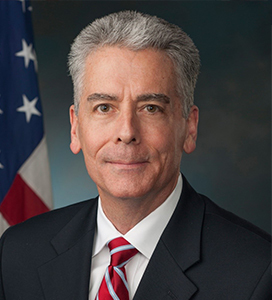
Frank Larkin
Member, Veterans Advisory Council
Frank Larkin
Member, Veterans Advisory Council
Frank Larkin was formerly the United States Senate Sergeant at Arms (SAA). As chief law enforcement and executive officer of the Senate, the SAA enforces rules of the Senate; provides a range of technical and administrative services to Senators in their Washington, DC, and state offices; and maintains security in the Capitol and Senate office buildings.
Frank was a member of the Senior Executive Service, recently serving as both the Acting Director and the Vice Director of the Joint Improvised Explosive Device Defeat Organization (JIEDDO) within the Department of Defense. He previously served as JIEDDO’s Director for the Counter IED Operations-Intelligence Integration Center. JIEDDO’s mission was to focus all Department of Defense actions in support of the combatant commanders’ efforts to defeat improvised explosive devices (IEDs) as weapons of strategic influence. Frank’s focus was in support of our deployed warfighters and special operations forces around the globe and the integration of a “whole of government” disruption effort targeting extremist networks that employ IEDs.
Frank served for more than two decades in the United States Secret Service (USSS), beginning in 1984 as a Special Agent assigned to the Philadelphia and Washington Field Offices, before assignment to the Presidential Protective Division. He was assigned to the Office of Congressional Affairs for a two-year fellowship on Capitol Hill, serving a year each with the Senate and House Appropriations Committees. Frank entered the USSS supervisory ranks as Assistant to the Special Agent in Charge of the New York Field Office, where he led financial, electronic, and organized crimes investigations. Following the events of 9/11, he returned to Washington, DC, as the Assistant Special Agent in Charge of the Presidential Protective Division, supervising White House security operations. As Assistant Special Agent in Charge of the Technical Security Division, Frank was responsible for tactical countermeasures programs. In 2004, he was promoted to the Senior Executive Service, assuming the position of Deputy Assistant Director for Protective Research and Chief Technology Officer.
Following his USSS career, Frank was Director, Program Management & Leadership, for the Raytheon Company, and more recently, worked at Lockheed Martin’s Defense & Intelligence Solutions, responsible for providing operations and intelligence analysis support to the intelligence community.
A veteran of the US Navy, Frank has a significant military and law enforcement special operations background, serving as a special warfare operator in the Navy SEALs. After his Navy service, he was a uniformed patrol officer with the Norristown (PA) Police Department, a homicide detective with the Montgomery County (PA) District Attorney’s Office, and a Maryland State Trooper-Flight Paramedic.
Frank holds a BA degree in criminal justice and an MS degree in public administration from Villanova University. He is the recipient of numerous awards, including the US Secret Service award for valor, the Department of the Army’s Exceptional Civilian Service award, and the Superior Civilian Service award.
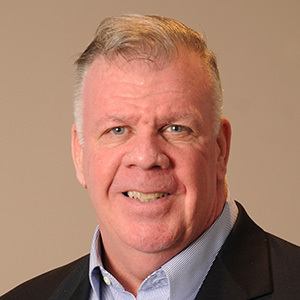
LTG John F. Mulholland, U.S. Army (Ret).
Member, Veterans Advisory Council
LTG John F. Mulholland, U.S. Army (Ret).
Member, Veterans Advisory Council
The proud son of a USAF fighter pilot and Korean War veteran, Lieutenant General Mulholland John Francis Mulholland, Jr. (Retired) was born in Clovis, New Mexico, but grew up in Bethesda, Maryland. He earned a Bachelor of Arts in History and was commissioned as a Second Lieutenant of Infantry, United States Army upon graduating from Furman University, Greenville, South Carolina, in 1978.
As a young Infantry officer, LTG Mulholland (Ret) served as platoon leader of both mechanized and airborne rifle platoons, as well as mortar platoon leader. Since joining the 1st Special Forces Regiment in 1983, LTG Mulholland (Ret) commanded from the captain through lieutenant general-level in Army and joint special operations forces, including serving as Deputy Commanding General, Joint Special Operations Command, as the Commanding General, United States Army Special Operations Command, and as the 15th Deputy Commander, United States Special Operations Command. Following graduating from the National War College in 2001, then-COL Mulholland assumed command of the 5th Special Forces Group, Airborne at Ft. Campbell, KY. In the immediate aftermath of the attacks of 9-11, Colonel Mulholland commanded Joint Special Operations Task Force-North (Task Force Dagger) in the opening days of Operation ENDURING FREEDOM and, later, Combined Joint Special Operations Task Force-West (Task Force Dagger) in the initial campaign of Operation IRAQI FREEDOM.
LTG Mulholland’s (Ret) overseas assignments included two tours in the former Panama Canal Zone, command of the 1st Battalion, 1st Special Forces Group (ABN), Okinawa, Japan and as the Chief, Office of Military Cooperation, Kuwait. LTG Mulholland (Ret) served at and completed his final tour on active duty as the Associate Director of Military Affairs, Central Intelligence Agency. LTG Mulholland (Ret) is married to the former Miriam Mitchell. Together, they have 4 grown children and 5 grandchildren. LTG Mulholland (Ret) and Miriam now operate Mulholland Consulting, LLC in Alexandria, Virginia.
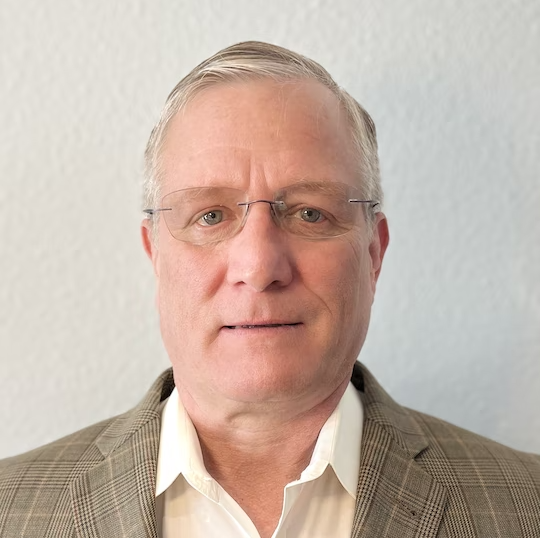
Tim Szymanski, VADM, U.S. Navy (Ret.)
Member, Veterans Advisory Council
Tim Szymanski, VADM, U.S. Navy (Ret.)
Member, Veterans Advisory Council
Tim has served in many Navy and Joint Special Operations assignments as a Navy Special Warfare Officer (SEAL) for over 36 years. He most recently served as the Deputy Commander for United States Special Operations Command (USSOCOM) after serving as the Commander of Naval Special Warfare (NSW). In both roles he oversaw the manning, equipping and training, and employment of NSW and joint special operations forces, of 11,000 and 73,000 uniformed and civilian personnel, respectively.
He has an extensive background in raising, equipping, and training Navy, allied and joint special operations forces and has served operationally in Iraq, Afghanistan, Haiti, and other places of crises. As Deputy Commander USSOCOM and as Commander NSW he spearheaded force design and development initiatives, led organizational culture reviews and implementation plans, and developed leaders throughout the force.
Keenly aware of the detrimental effects of invisible wounds on Force and Family Readiness, he established policies and developed lines of effort to monitor, protect and enhance warfighter brain health.
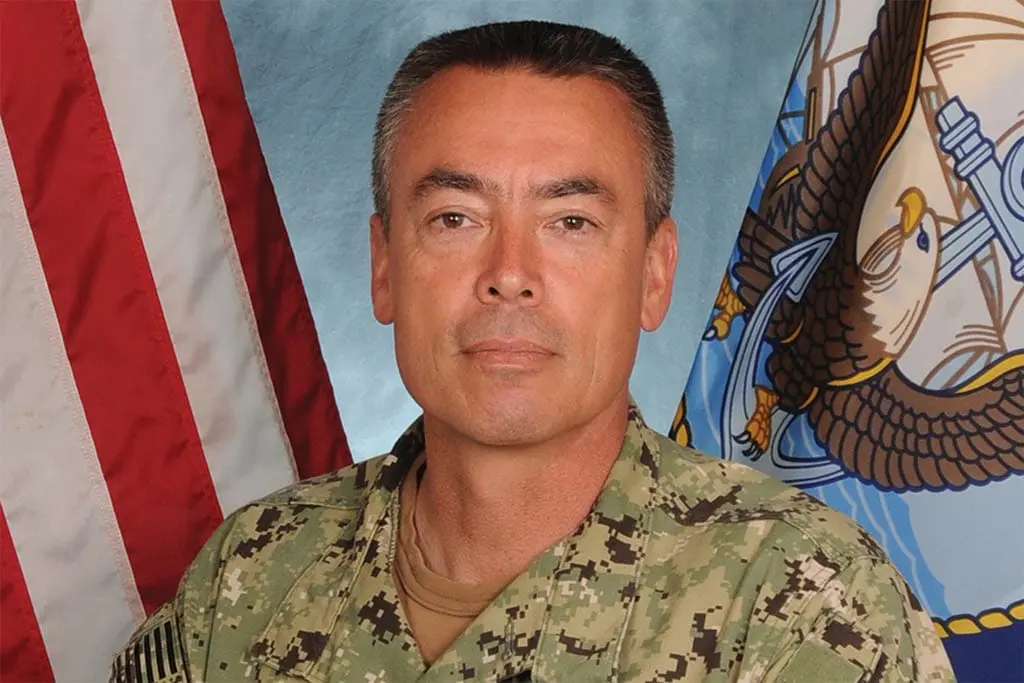
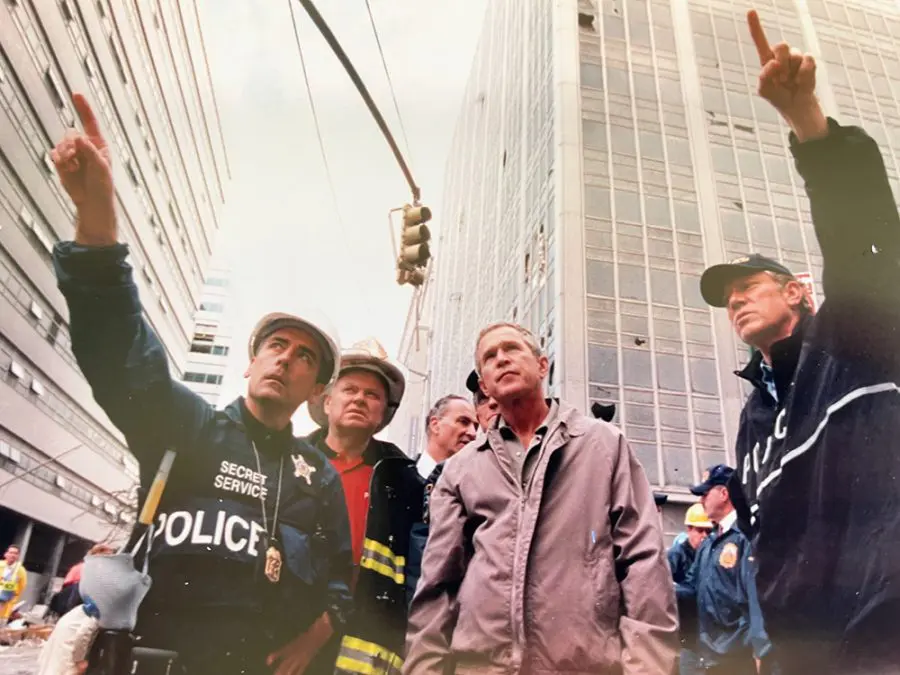
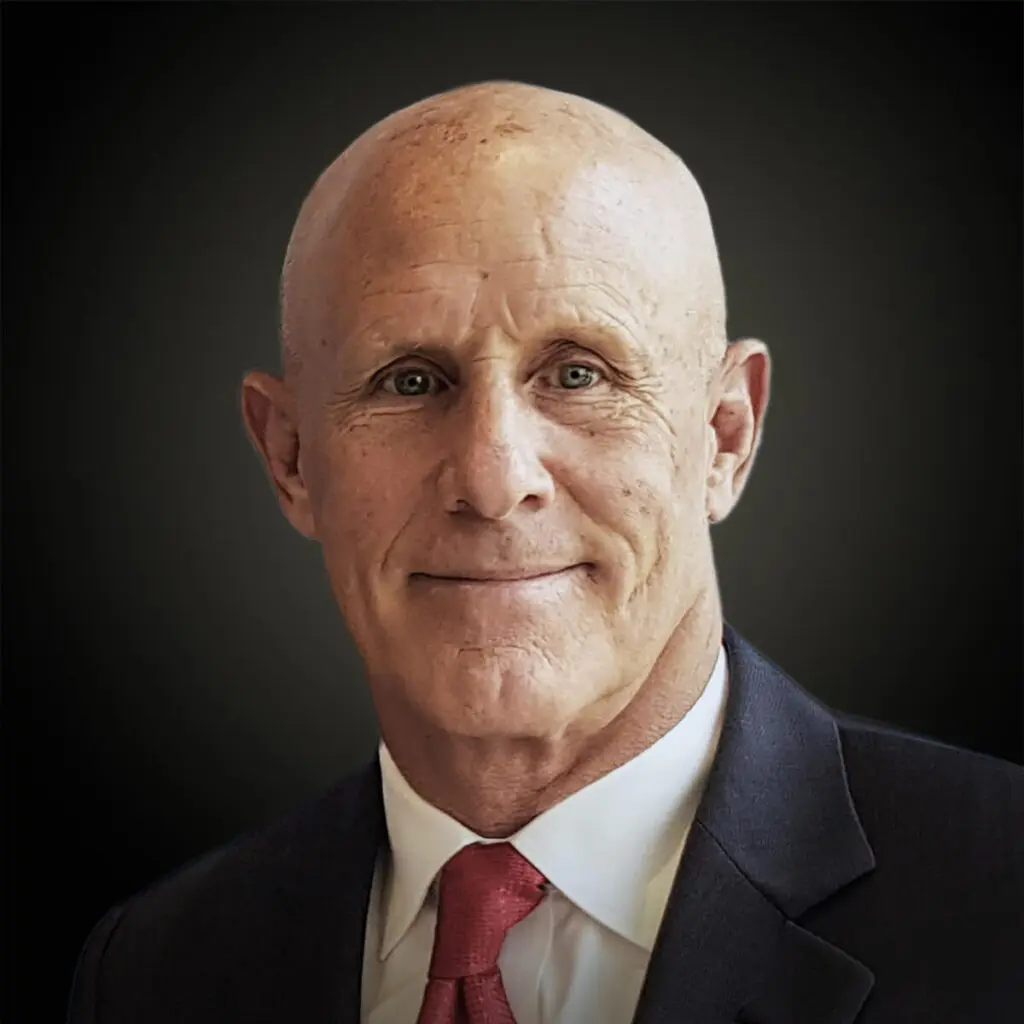

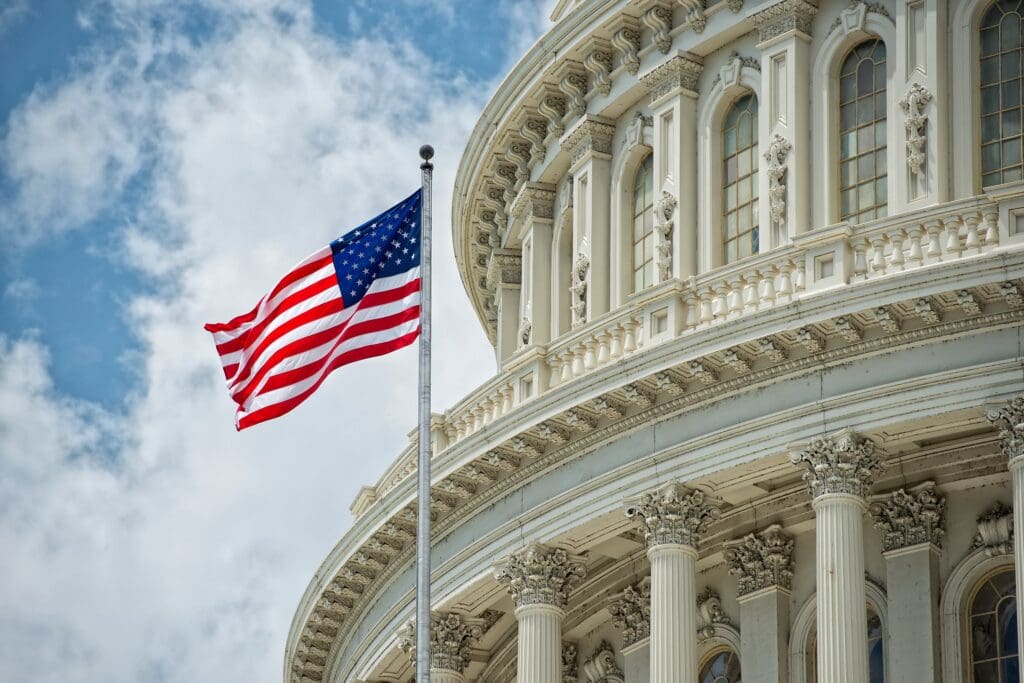
Cohen Veterans Bioscience is a non-profit 501(c)(3) biomedical research and technology organization dedicated to advancing brain health by fast-tracking precision diagnostics and tailored therapeutics.
Cohen Veterans Bioscience is a non-profit 501(c)(3) biomedical research and technology organization dedicated to advancing brain health by fast-tracking precision diagnostics and tailored therapeutics.
©2023 Cohen Veterans Bioscience | Privacy Policy | Terms of Use
